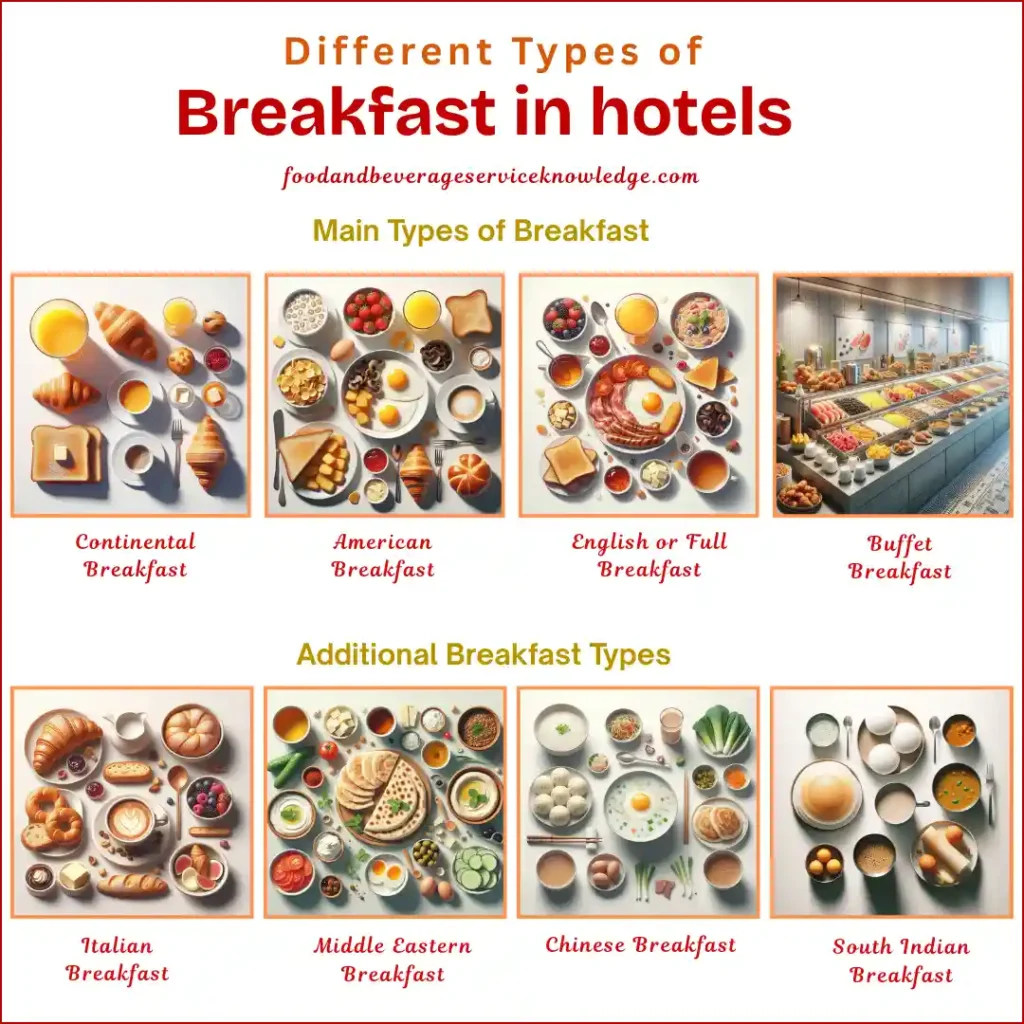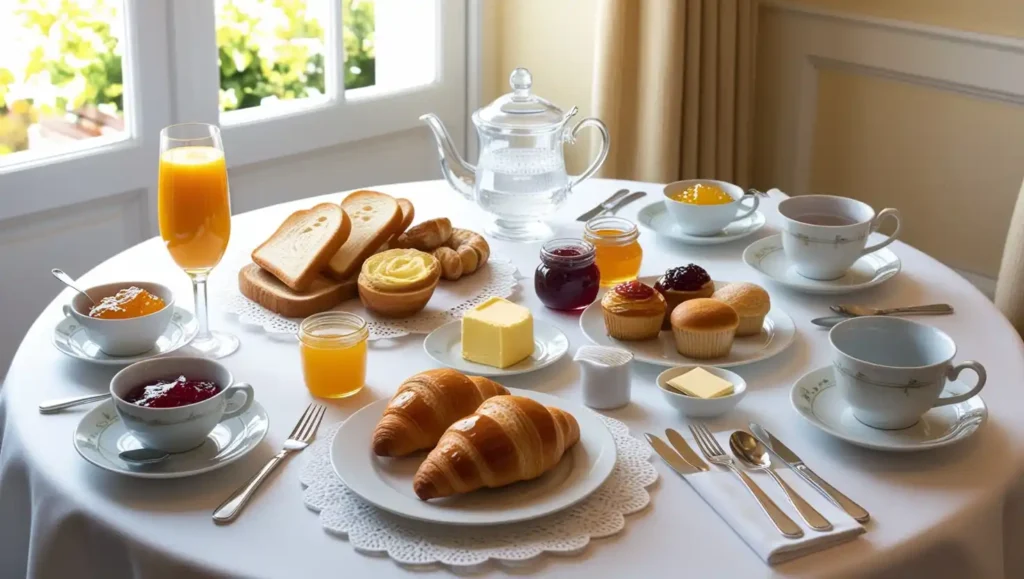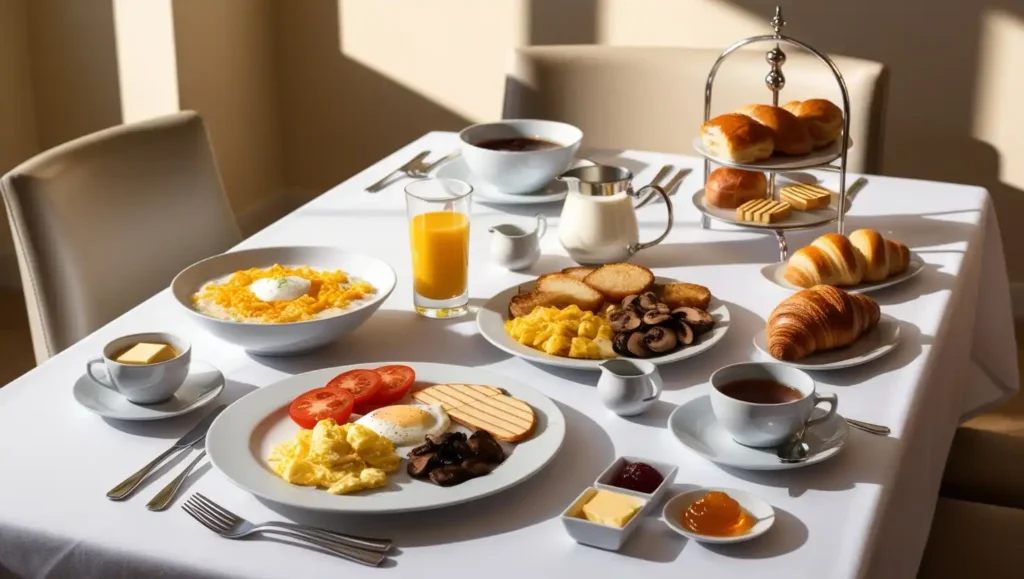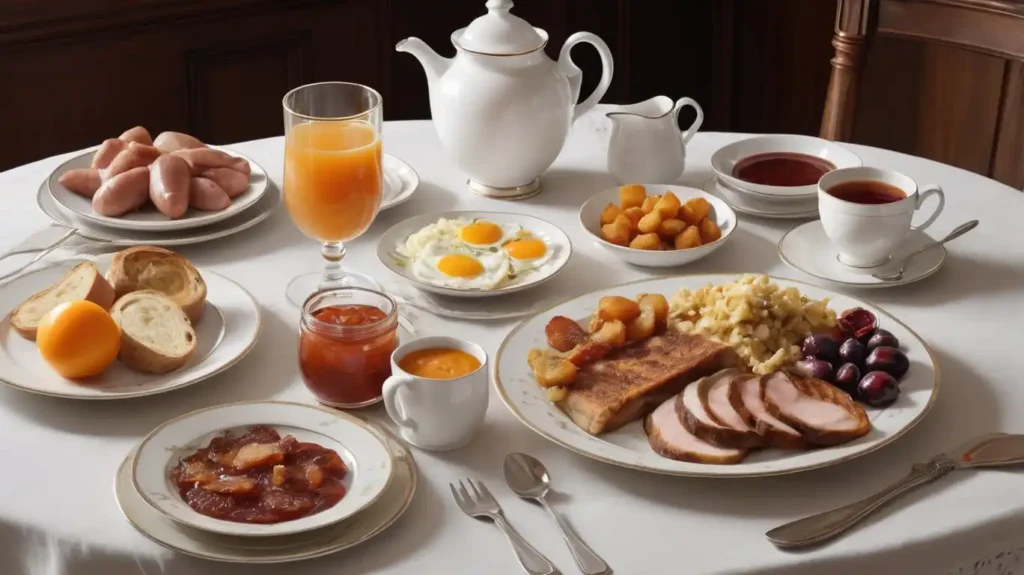Breakfast is often described as the most important meal of the day—and for good reason. After a night of fasting, it’s the first opportunity to refuel the body and kickstart metabolism. For hotel guests, breakfast is more than just a meal; it’s an experience. It sets the tone for the day and, in many cases, becomes a lasting impression of the hospitality they receive.
In the hospitality industry, breakfast is also a key driver of guest satisfaction. A well-planned breakfast menu can elevate a hotel’s reputation, improve guest loyalty, and even generate positive reviews.
For this reason, hospitality professionals must have a deep understanding of the various types of breakfast served around the world in both hotel and restaurant service—what they are, how they differ, and when to offer them.
What Are the Main Types of Breakfast?
Across hotels and cultures, breakfasts can be broadly categorised into four main types:
- Continental Breakfast: A light, European-style breakfast often featuring pastries, bread, jam, and coffee or tea.
- English or Full Breakfast: A hearty plate loaded with eggs, sausage, bacon, baked beans, and more—popular in the UK and beyond.
- American Breakfast: Similar to the English breakfast but often includes pancakes, waffles, and hash browns.
- Buffet Breakfast: A self-service spread offering a wide variety of hot and cold dishes to suit every palate.
Additional Breakfast Types:
Beyond the traditional staples, global tastes have shaped additional breakfast styles that are increasingly relevant in hotels and restaurants. These include:
- À la Carte Breakfasts – Where guests order individual items off a menu, often in luxury or boutique hotels.
- Regional breakfasts are traditional morning meals unique to specific countries or cultures, shaped by local ingredients and culinary customs. like Italian, Chinese, indian, and French.
- Mediterranean Breakfast – A heart-healthy, plant-rich option common in coastal Europe and North Africa.
- Vegan or Plant-Based Breakfast – Growing in popularity due to health and environmental awareness.
Discover the various types of breakfast served in hotels around the world with this visual infographic.

Explore the Different Types of Breakfast in Detail
Let’s dive into the detailed breakdown of each breakfast type, focusing on what they typically include, how they are served, and their significance in hospitality. This content is crafted for both hotel management professionals and curious general readers, with a focus on clarity, value, and readability.
1. Continental Breakfast
Light, Elegant, and European-Inspired

The continental breakfast is a light, cold breakfast originating from Western Europe, typically consisting of pastries, bread, butter, preserves, and hot beverages like tea or coffee. It excludes cooked items and is ideal for guests who prefer a quick, minimal meal.
Commonly served in business hotels, B&Bs, and budget accommodations, it’s also popular for room service due to its simplicity and ease of preparation. This breakfast style emphasises convenience and elegance without the heaviness of a full meal.
Structure: 3 Courses
- Chilled Fruit Juice: Fresh or canned (orange, apple, mango, etc.), served in a pony glass placed on a doily-lined underplate.
- Toast or Breakfast Rolls: Served with preserves, butter, and honey.
- Hot Beverage: Choice of tea or coffee.
Breakfast Rolls includes: Croissants, Danish pastries, Brioche, Muffins, Doughnuts
Common Preserves: Jam, Jelly, Marmalade
Standard Continental Breakfast Table Setting
- Napkin
- Side plate and side knife
- Teacup and saucer with a teaspoon
- Sugar basin with sugar tongs and individual sugar packets
- Tea strainer and slop basin
- Butter dish with butter knife
- Preserves pots (jam, jelly, honey, marmalade)
- Toast rack or breadboard with serviettes
- Water goblet
Hospitality Insight: Ideal for quick service and minimal labour, the continental breakfast is perfect for guests on the go, business travellers, or budget hotels.
Service Style:
- Table d’hôte (most common): Offered as a fixed breakfast set in many hotels, especially budget or business-class properties.
- À la carte: Available in cafés or restaurants where guests select individual bakery items, drinks, or add-ons.
Certainly! Here’s a concise 2-line example referencing the external link:
For a real-world example of a hotel-style continental and buffet breakfast offering, check out the Elgin Country Club Breakfast Buffet Menu.
View the full menu (PDF) – includes pastries, fruits, beverages, and more.
2. American Breakfast
Heartier and Protein-Rich with a Touch of Sweet

The American breakfast is a full, cooked meal that typically includes eggs (any style), toast or pancakes, and breakfast potatoes, often accompanied by juice, coffee, or tea. Unlike the lighter continental style, it offers a blend of savoury and sweet items, catering to diverse palates and higher energy needs.
Commonly served in upscale hotels, resorts, and international properties, this breakfast is favoured by guests seeking a filling and satisfying start to the day. It is often presented as a table d’hôte set or featured in buffets with live egg stations.
Structure: 5 Courses
- Chilled Fruit Juice: Served similarly to a continental breakfast.
- Breakfast Cereals: With hot or cold milk
- Egg Course (Guest’s Choice): Prepared as omelettes, scrambled, poached, or fried
- Accompaniments: Hash browns, Grilled tomato, Sautéed mushrooms, Wafers, Tomato ketchup
- Toast or Breakfast Rolls: Served with butter, honey, and preserves
- Hot Beverage: Tea or coffee
Cereals Examples: Cornflakes, Choco flakes, Wheat flakes, Muesli, Oatmeal, Rice crispies
American Breakfast Cover Setup
- Napkin
- Side plate, side knife
- Egg spoon, cereal bowl, soup spoon
- Teacup, saucer, teaspoon
- Sugar basin with tongs and packets
- Tea strainer, slop basin
- Breadboard or toast rack with serviettes
- Butter dish and knife
- Preserves pots
- Water goblet
Hospitality Insight: This type of breakfast is more labour-intensive but popular in hotels that aim to offer a full-service, value-added guest experience.
Service Style:
- Table d’hôte: Usually served as a standard set meal in hotels that include breakfast in room tariffs. It includes several courses served at the table.
- À la carte: Offered in restaurants or through room service, where guests can pick specific dishes (e.g., eggs, sides, beverages) individually.
3. Full English Breakfast
A Grand Multi-Course Morning Feast

The Full English Breakfast, often called the “full breakfast,” is a hearty, multi-course meal featuring a variety of cooked items such as fried or scrambled eggs, bacon, sausages, grilled tomatoes, mushrooms, baked beans, and toast. This traditional breakfast is rich and filling, designed to provide sustained energy throughout the day.
It is commonly served in British hotels, bed and breakfasts, and upscale international properties aiming to offer guests a luxurious and leisurely dining experience steeped in British culinary heritage. Often enjoyed as a table d’hôte or à la carte meal, it highlights the cultural importance of breakfast in the UK.
Structure: 9 Courses
- Chilled Fruit Juice
- Fresh Fruits: Banana, apple, mango, watermelon, etc.
- Stewed Fruits
- Apples, prunes, figs, pears, cooked in sugar syrup
- Flavoured with clove and cinnamon
- Served in a cocktail glass on a doily with a dessert spoon
- Breakfast Cereals: With hot or cold milk
- Fish Preparation: Grilled or poached fish (e.g., kippers, haddock)
- Egg Preparation (Guest’s Choice): Omelettes, poached, fried, or scrambled eggs with grilled tomato, sautéed mushrooms, hash browns, and ketchup
- Meat Course: Bacon, sausage, ham, salami, or offal like kidney/liver
- Toast or Rolls with Preserves
- Tea or Coffee
English Breakfast Cover Setup
- Napkin
- Side plate and knife
- Cereal bowl, soup spoon
- Fish fork and knife
- Joint (meat) fork and knife
- Teacup, saucer, teaspoon
- Slop basin and tea strainer
- Sugar basin and tongs
- Toast rack or breadboard with serviettes
- Butter dish and knife
- Preserves and honey pots
- Water goblet
Hospitality Insight: This breakfast signals elegance and indulgence. It’s best suited for leisure guests, long-stay travelers, and traditional British-themed hotels.
Service Style:
- Table d’hôte: Traditionally served as a complete set breakfast, especially in British-style hotels, inns, and resorts.
- À la carte: Components like eggs, meats, and sides are often listed separately in restaurants for guests who want to customise.
4. Buffet Breakfast
Self-Service, High Variety, and Global Flexibility

The buffet breakfast is a popular, self-service style meal that offers guests a wide range of options, from fresh fruits, cereals, and pastries to hot cooked dishes and beverages. It is especially favoured in busy hotels and resorts catering to diverse, international clientele, as it allows guests to customise their meals according to personal preferences and dietary needs.
This format promotes efficiency during peak hours, reduces wait times, and often includes live cooking stations for made-to-order items like eggs or pancakes. Buffets also allow hotels to showcase both local specialities and international favourites, enhancing the overall guest experience
Advantages for Hotels
- Reduces waiting time and service staff requirement
- Accommodates large volumes during rush hours
- Provides guests with a variety of options
- Controls food cost with bulk preparation
- Customizable with local specialities
Typical Buffet Inclusions
- Juices – Fresh or canned
- Fresh-cut fruits
- Cereals with milk – Cold and hot options
- Live egg station – Made-to-order omelettes, scrambled, boiled, etc.
- Meat station – Bacon, ham, sausages, grilled chicken, or liver
- Bakery section – Bread, muffins, pastries
- Hot beverages – Tea (black, green, lemon), coffee (espresso, cappuccino, etc.)
Hospitality Insight: Buffets are cost-effective for large properties, offer perceived value, and reduce service bottlenecks. They’re a win-win for guests and operations alike.
Service Style: Guests pay a fixed price (like table d’hôte)
Regional Breakfasts: A Global Flavor Experience
In the modern hospitality industry, offering regional breakfast options is more than a trend—it’s a strategic way to provide authentic, culturally relevant experiences. Hotels, especially international chains and boutique properties, increasingly tailor their breakfast menus to reflect local flavours or to appeal to the cultural preferences of their guests.
Italian Breakfast
Typical Components:
- Espresso or cappuccino
- Pastries such as cornetti (Italian croissants), biscotti, or sfogliatelle
- Bread with butter and fruit preserves
- Occasionally, yoghurt or fresh fruit
Style: Light and sweet
Service Style: Usually à la carte or part of a continental buffet
Hospitality Insight: Italians prefer a quick, simple breakfast. Hotels catering to Italian guests (or themed properties) often provide espresso machines and a pastry station.
Middle Eastern Breakfast
Typical Components:
- Flatbreads (pita or khubz)
- Labneh (strained yoghurt), hummus, and feta cheese
- Olives, cucumbers, and tomatoes
- Boiled or fried eggs, za’atar, and falafel
- Mint tea or strong black coffee
Style: Savoury, fresh, protein-rich
Service Style: Buffet or table d’hôte platter
Hospitality Insight: Emphasise shared platters and small dishes. Middle Eastern guests value variety and freshness, and often seek halal options.
Chinese Breakfast
Typical Components:
- Congee (rice porridge) with pickled vegetables or meats
- Baozi (steamed buns) and jiaozi (dumplings)
- Tea eggs, scallion pancakes, and soymilk
- Chinese tea or hot water
Style: Warm, savoury, and filling
Service Style: Buffet or à la carte with custom orders
Hospitality Insight: Popular in hotels across Asia and in properties with Chinese guests. Congee stations with toppings offer a high-impact, low-cost personalisation element.
South Indian Breakfast
Typical Components:
- Idli (steamed rice cakes), dosa (crispy rice crepes)
- Vada (fried lentil doughnuts)
- Served with sambar (spiced lentil stew) and coconut chutneys
- Filter coffee or masala tea
Style: Vegetarian, spicy, light but satisfying
Service Style: Often buffet or table d’hôte combo platter
Hospitality Insight: Ideal for health-conscious and vegetarian guests. These dishes require special preparation, so staff training and consistency are key.
North Indian Breakfast
Typical Components:
- Aloo paratha (stuffed potato flatbread) with curd
- Chole bhature, puri bhaji, or poha
- Pickles, butter, and chutneys
- Accompanied by masala chai
Style: Hearty, robust, and full of flavour
Service Style: Often offered as part of a buffet or on set plates
Hospitality Insight: North Indian guests expect hot, freshly made items. Consider live counters for parathas or puris for a premium touch.
Other Regional Breakfasts Worth Mentioning:
| Region | Common Breakfast Elements | Notes |
|---|---|---|
| Japanese | Miso soup, grilled fish, rice, pickles, tamagoyaki (omelet) | Light, balanced, ideal for wellness-focused hotels |
| French | Croissants, pain au chocolat, café au lait, fruit preserves | Similar to continental; best in boutique properties |
| American Southern | Biscuits and gravy, grits, bacon, sweet tea | Ideal in themed or regional hotels in the U.S. South |
| Mexican | Chilaquiles, tamales, huevos rancheros, refried beans | Bold flavors; great in resorts or heritage hotels |
| Korean | Kimchi, rice, grilled fish, soup, banchan (side dishes) | Best in Korean-popular markets or fusion hotels |
FAQ
1. What is the difference between a continental and an American breakfast?
A continental breakfast is light and typically includes pastries, bread, butter, preserves, and hot beverages—no cooked items. In contrast, an American breakfast is heartier, with cooked dishes like eggs, bacon, sausages, and toast, often accompanied by juice and coffee.
2. What is usually included in a full English breakfast?
A full English breakfast typically features eggs, bacon, sausages, baked beans, grilled tomatoes, mushrooms, toast or fried bread, and sometimes black pudding. It’s a rich, multi-course meal served hot, often enjoyed in British hotels and traditional B&Bs.
3. Do hotels serve regional or international breakfasts?
Most hotels offer a mix of regional and international breakfasts to cater to global guests. High-end or culturally themed hotels may highlight regional breakfast options (like Indian, Japanese, or Middle Eastern) to enhance authenticity and guest satisfaction.
Also Read:
- Types of Bars: A Complete Guide for Hospitality Professionals
- Waiter/Waitress Job Description: Duties, Responsibilities, and Essential Skills
- Classification of Soup: Main Types and Examples
- What Are the Different Types of Cooking Methods? Explained with Examples
- Classification of Beverages: Alcoholic and Non-Alcoholic Explained
This article was written by Saswata Banerjee, the creator of Food and Beverage Service Knowledge, based on 8+ years of experience in the hospitality industry.


